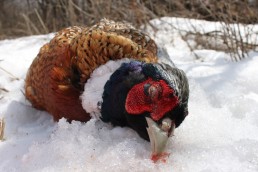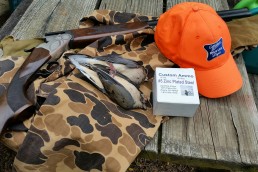Tips for Hunting Wisconsin Mourning Doves
SHARE THIS POST
Wisconsin had its first modern-day mourning dove hunt way back in 2003, after a long legal battle of sportsmen and Wisconsin DNR vs. anti-hunters. I hunted that season, and every season since, and I’ve learned a lot! Besides being fun to hunt, doves are a challenging target for even the best shots, and great table fare. Here are a few ideas on how to increase your harvest of these sporty little game birds.
Population
Per the latest estimates by the U.S. Fish & Wildlife Service, there are about seven million mourning doves (Zanaida macroura) in Wisconsin. Long-term population monitoring shows steady increases in the dove population in our area. About four to five million doves migrate south every winter, starting in late September. From what I have seen over the years, I suspect the migration starts in earnest around the first couple weeks of October, and peaks mid-month. This is when you will get those flocks of twenty or so doves that will swing over your decoys. New to the hunt in the last few years are Eurasian collared doves (Streptoelia decaoto), a newly arrived invasive species. These are larger than the more common mourning dove and have a distinct black band around the neck. There are colonies of this newcomer in western Wisconsin, and I have seen them in Dodge and Fond Du Lac counties.
Doves live on waste grain and weed seeds; it comprises over 90 percent of their diet. They will gleefully consume just about any grain out there. Corn, wheat, soybeans, sunflowers, safflowers, oats, millet, etc., and the seeds of about weed seeds they can find. They need grit like sand or fine gravel for digestion, and a water source. Evergreen trees are a preferred roosting place, as they offer cover from hawks and owls. Scout out a spot that contains as many of these things as you can find, and you should find doves.
Hunt the food sources
Cut corn, wheat, soybean or harvested grain fields are dove magnets. You can observe where the birds enter the field and pass shoot them, but decoys are often a better tactic. I like to get in before first light and set up my decoys. Note that doves, like other birds, like to land into the wind. I’ll set up a half-dozen dove decoys, and at least one “spinner” (motion decoy) where they will be visible to passing birds. Another trick I use is to also place a few barn pigeon decoys next to the dove decoys. Feral (barn) pigeons often feed with doves, and are larger and more visible. Set the decoys in a loose X with an open spot next to your “spinner.” Barn pigeons, a larger, domesticated member of the same family of birds as doves, are unprotected, and have no season or bag limit. I have often killed them on farm country dove hunts, and they cook up just as good as the doves.
Hunt the water or grit
Doves will use just about any water they can find: Anything from a crystal-clear pond to a muddy puddle in a tractor trail. I’ve set dove decoys right out in the mud puddles and killed birds coming into them. Any exposed sand pits or fine gravel also draws doves. Use decoys and remember not to over-hunt and burn out your spot. Relentless shooting pressure will make the birds find a safer water or grit source. As with a lot of other birds, freshly spread manure will draw doves and pigeons.
Hunt the flight lines
When out hunting doves, you will begin to notice birds using well-defined flight lines to move from roosting cover to feeding sites or water. These are often farm roads, tree lines or field edges. Doves can be pass shot by setting up on a flight line early in the day or towards evening. Decoys can be set on fences or trees to attract or at least slow down passing birds for a shot. Be careful not to “educate” the birds by gunning the same spot day-after-day. Move your spot around so the birds don’t change their route.
Are you enjoying this post?
You can be among the first to get the latest info on where to go, what to use and how to use it!
Guns and loads
Wisconsin law requires the use of steel shot on public lands for doves, and shotguns to be plugged to hold no more than three shells. I have no problem with using steel, as a lot of my dove hunts are done along with early September goose hunts, where the possession of lead shot is prohibited anyway. Use 1-ounce loads of steel #6 shot in a 12 gauge, or 3/4-ounce loads of steel in a 20 gauge. Only a few pellets are required for a clean kill on doves. If hunting only doves on private land, where lead loads are still legal, trap loads of #7 1/2 shot or those light 1ounce “game loads” work wonders for doves. I will admit to having no time to change shells during an October goose hunt when a big migrating flock of doves buzzed me in a cut cornfield. Yes, you can harvest doves with #1 and BB steel goose loads, but it’s costly and not recommended.
Take a kid hunting
Our 2020 dove season opens September 1 and runs all the way until the end of November. Hunters who only hunt the first few weekends are missing out. Mid-October migrating flocks can make for some fantastic shooting. Those first warm, user-friendly days of the season are a great time to get young hunters started. Dove hunting doesn’t require any fancy gear or guns, and the light, low-recoil hunting loads help to make this a perfect first hunt. Young hunters will learn patience, sitting still, and how to watch for game, and they should have more than a few opportunities to shoot birds. I suggest sitting in a blind, and setting out decoys for easy shots. My son Adam killed his first game bird on a dove hunt with my old .410 shotgun.
Doves have dark meat similar to other migratory birds. I usually fillet out the breast and soak the meat in saltwater overnight. The meat can be made in any manner of ways, from a simple stir fry or an elaborate bacon and jalapeno wrap with cream cheese. I often marinate in a dry red wine, soy sauce and garlic, then grill over low heat until cooked through. You can also make it with recipes using duck or goose meat. Hunt safe and good luck!
Become a MidWest Outdoors Insider here!
MWO
SHARE THIS POST
Did you enjoy this post?
You can be among the first to get the latest info on where to go, what to use and how to use it!
Ron Stresing
Ron Stresing has fished since age 4 and hunted since age 12, with a lifelong passion for both. He tries to convey the lessons learned over a lifetime of hunting and fishing in Wisconsin. He also writes a column on shotguns for On Wisconsin Outdoors.



